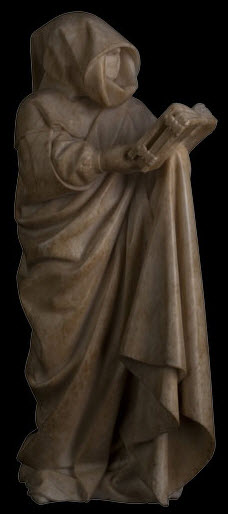 I needed to take a break from my paper (with its final version due this Monday), so I decided to visit the Metropolitan Museum of Art, my favorite museum that happens to be right here in New York.
I needed to take a break from my paper (with its final version due this Monday), so I decided to visit the Metropolitan Museum of Art, my favorite museum that happens to be right here in New York.
What a surprise when I stumbled across one of the best (small) exhibits I have ever encountered, The Mourners: Tomb Sculptures from the Court of Burgundy. This exhibit is the first time these sculptures have been separated from the tomb in Burgundy they have been mourning for hundreds of years. Arranged in 2 rows, they walk and mourn in silence, doing what people have done for thousands of years–remember those who have come before. They are carved in amazing detail, only 16 inches tall, and arranged in the Medieval sculpture hall in a solemn and thought-provoking manner that stopped me in my tracks.
I love Medieval art. I love France. What a find to invite me to be as introspective as these fellows are.
In our own ways, and in mine in particular, I find myself reflecting on my past, much as these statues do. I constantly replay images from the past, thinking, from different perspectives, about how to live the present and prepare for a better future while being informed by what has gone on before. It is not that often that I get overwhelmed with an entire art display, though this one, as if walking toward the doorway through which I entered, greeted me as if personally and solemnly.
Do I mourn? Will others mourn me? I wonder to what extent anything of mine will even be remembered after I finish my journey?
While this can immediately be seen as a lament, I will instead take this as an invitation to make the remainder of my life memorable. I want to leave the world a better place, be part of something greater than myself.
What better response to have to works of art, than to want to take positive action?
What do you want people to remember about you?
Looks like an incredible exhibit; sounds like an amazing experience. I don’t know what I want people to remember about me. I don’t know that we choose. But I suppose I hope that my children will do greater things and be, in every way possible, better than I…
I think– actually I KNOW– one of the reasons I am so big on writing paper letters, writing in the margins of books, and other such physical acts are because they leave traces that are potentially of relative permanence… it’s not the motivation, but it is a part of it…
Chris, this exhibit left me absolutely breathless. It was like coming over a hill and seeing a landscape ahead that was unexpected and completely engaging. In a museum with priceless works of art, the brilliance of those who put this together and had the mourners walk toward us, with the opportunity to walk around them, as they seemingly continued on with their tasks . . .
Your insight makes me wonder about our electronic world. I know I am engaged nearly full-time on technology-related tasks that, with the flick of a switch, would leave me with little trace of my life. Alas, to be more in touch with the world in which we move and breathe and have our being.
Thank you for sharing.
Jeffrey
I love those unexpected experiences that can come from smaller exhibits. My son and I were traveling in Colorado once and came across a Chihuly exhibit… I like Chihuly’s work, but finding his exhibit in a small museum– a large gallery, really– was pure serendipity. And then we came across this one installation, a simple one: a totally dark room, all draped in black, with shards and fragments of glass all over the floor, with these planet-like glass spheres nestled amongst them. So simple, so small– but it left me in tears, contemplating, well, *everything*. Our place in this huge universe, existence, how art can be at once so small and at once let us touch that which is most vast. No way I’ve ever been able to put words to it, even as a poem.
Like the exhibit you describe, that installation is gone. It could be recreated in some fashion, but that instance existed for just an instant. Its own impermanence part of what has made it permanent in my mind.
For all the talk about being haunted by our digital history, the reality is that there’s very little *practical* permanence to it… it’s all theoretical.
A hunger to engage with something of permanence is part of why I write poetry… art has, potentially anyway, a longer life than *anything* in technology and education except, perhaps, the art that might be made by a student.
Chris-
I have been thinking about your comment all week, and have been struck about the issue related to *practical* permanence in our digital histories. Makes me wonder how our identities may cease to exist if we let our online subscriptions expire.
I wonder what this does with our sense of identities themselves?
Jeffrey